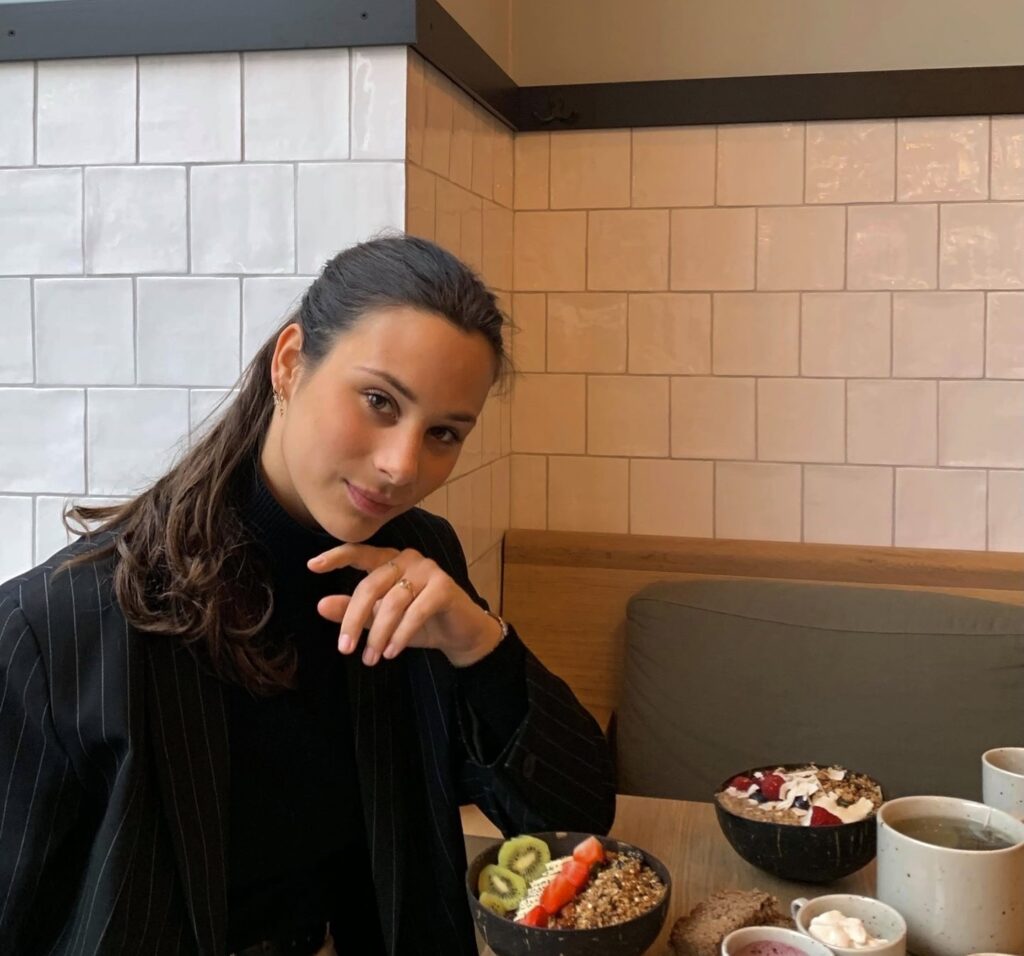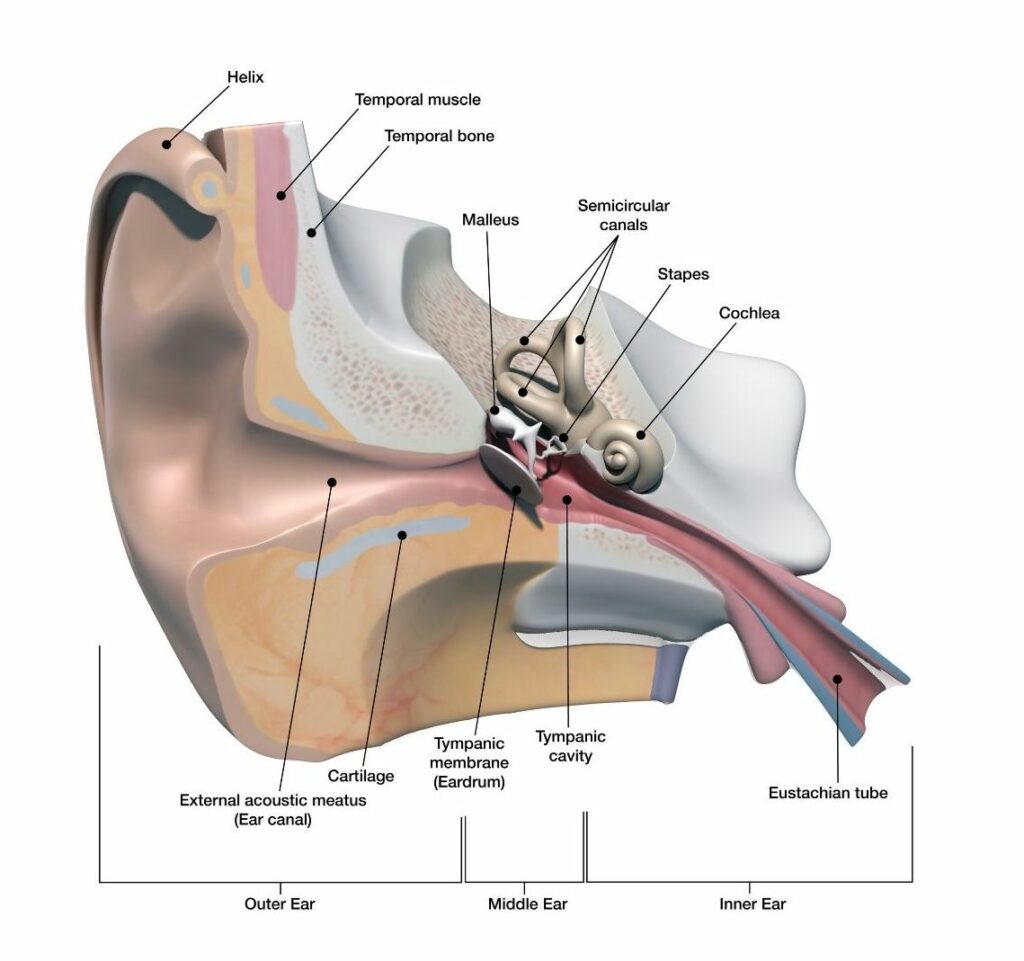
My name is Kaat Colman and I’m currently completing my third Bachelor year in Biomedical Sciences at UAntwerp. Ever since I was a teenager, I’ve been fascinated by the human body. The idea that our body is occupied with countless processes every millisecond of the day to function optimally is truly fascinating to me. Over the past three years, I have gained a lot of knowledge about many processes in the human body. However, there is of course a difference between gaining knowledge and gaining hands-on experience. As I am an active and sociable person, I was eager to discover what it would be like to work in a research environment.
In the 3rd Bachelor of Biomedical Sciences there is the course ‘Bachelor Thesis with Internship’. I had to choose a topic on which I would write my Bachelor thesis and later also perform an internship. I chose to do an internship on the auditory system. More specifically, I focused on the ‘Diagnosis and Treatment of Hyperacusis’ as my Bachelor Thesis topic.

Hyperacusis, or noise sensitivity, occurs when everyday sounds seem much louder than they should. Individuals suffering from hyperacusis cannot endure ordinary sounds, for instance, an electrical device, ascending airplanes or fireworks. Also, there is a common misunderstanding that hyperacusis is closely related to tinnitus. But, hyperacusis is not the same as tinnitus. Tinnitus is the perception of sound when no corresponding external sound is present. Patients with tinnitus experience ringing or other noises in one or both ears and this noise isn’t caused by an external sound, and other people usually can’t hear it.

After writing my Bachelor thesis that was focused on hyperacusis, I did a three-week internship at the Antwerp University Hospital (UZA) with Dr. Laure Jacquemin. I was part of the Ear Nose and Throat (ENT) department, and it was a great opportunity for me to enhance my knowledge on the auditory system. The emphasis there was mainly on hearing loss and tinnitus, because many patients suffer from these. A fellow student, Janne Wouters, and I formed a team where we shadowed the varied and efficient team that was assembled by Dr. Jacquemin. We got an opportunity to greatly enhance both our clinical and statistical skills.
My internship program consisted of tinnitus and normal consultations, Cochlear Implant (CI)-fittings, research and STILL-testing. STILL-testing consists of various tests such as audio testing and measuring Event Related Potentials (ERP). Tinnitus, or the phenomenon where you suffer from hearing loss, which results in your brain compensating by generating its own sound, is a very common clinical disorder. Due to the three scheduled tinnitus consultations, I received a clearer view of the treatment strategy. First of all, attempts are made to determine what the cause is, which can be different for each patient. An otoscopy (a clinical procedure used to examine structures of the ear), a hearing test and an MRI (Magnetic Resonance Imaging) are routinely done. We also work with tinnitus questionnaires to outline the impact that tinnitus has on the patient’s life. A common occurrence is the loss of hearing of high frequencies. When the cochlea is damaged (e.g. due to a noise trauma) in the area of the hair cells, some sound will not reach the hearing center. Using MRI, it is also possible to exclude the presence of a tumor on the auditory nerve, which is known as a Vestibular Schwannoma.

After excluding a hearing nerve tumor, certain therapies can then be suggested. The standard treatment is Tinnitus Retraining Therapy, a group session where patients are taught what tinnitus is and how it arises. The reason for this is that tinnitus is a sound that can potentially evoke a lot of emotion. These emotions can be agitation, pain, irritation, stress, etc. Our Central Nervous System perceives this as a high importance sound. Thus patients are often caught in a vicious circle. As the thinking process is a major influencing factor, doctors first try to rectify this. Other therapies are also provided, such as neuromodulation or transcranial Direct-Current Stimulation (tDCS), Cognitive Behavioural Therapy (CBT) and the placement of a Cochlear Implant. tDCS is a form of electrical stimulation of the brain that aims to reduce hyperactivity in the auditory cortex in order to diminish tinnitus. Also, a psycho-social intervention called CBT can be used to improve the patient’s mental health.

When severe hearing loss or deafness occurs, Cochlear Implants can be placed. During this procedure, a surgeon, in this case Prof. Vincent van Rompaey, places electrodes in the cochlea so that the CI can take over the function of the hair cells and stimulate the auditory nerve. I also had the opportunity to see a surgical procedure and see how all the electrodes were checked during the operation to ensure that they were situated correctly and that they were giving a signal. After the operation, patients come back for a consultation to check if everything is working properly and whether they can hear every day sounds comfortably. These are the CI fittings, where audiologists can further refine the sounds and fine tune any specific wishes the patient may have. In this way, the programs of the CI can be installed or fine-tuned for each individual.
Finally, for the research part, I was given the opportunity to help with a clinical trial that was related to an internet-based Tinnitus Retraining Therapy (iTRT) group session in the treatment of tinnitus distress. The aim of this study was to determine whether the effectiveness of the sessions remains the same after switching from a live to an online event. Patients were required to fill out questionnaires before and after the group session. With the help of these questionnaires, we could evaluate whether or not a difference in effectiveness had occurred due to the switch from live to online group sessions.
This internship has not only greatly enriched my knowledge of audiology in general, but it also gave me a clearer view of what I want in my future career. I had the opportunity to talk to many people, with different specializations, perspectives and tips. I also gained a whole new perspective on the possibilities offered by Biomedical Sciences. For example, I met a PhD student who studied Biomedical Sciences and did her Master’s degree in Neurosciences. Currently, she is also part of the ENT department at UZA. Because the auditory cortex is an important part of the auditory system, her specialisation in Neurosciences was well suited for this study topic.
I would advise that you make a well-considered decision when choosing the subject of your Bachelor thesis. I strongly believe that if you do what you love, nothing feels like work!
At UZA, I discovered a completely new environment. I have always been very focused on my future, but after this internship I have the feeling that my ambitions have even been elevated to a higher level. To give a simple example: PhD studies never really interested me, but after completing this internship it might be a new goal to carry out my own research one day. This mind switch is easily explained by the fact that you keep learning by talking to people and asking about their experiences. My advice is that you should never be afraid to ask questions, because knowledge is always valuable. Be inquisitive! I feel very grateful that I had the opportunity to join the excellent Ear Nose and Throat department at UZA for my internship. The working environment was stimulating and pleasant and I discovered that the work opportunities in Biomedical Sciences are as wide and varied as you desire. This adventure will certainly influence my upcoming decisions for my future career.
I would like to express my deepest gratitude to the University of Antwerp, Dr. Laure Jacquemin, Prof. Vincent Van Rompaey and many others at UZA!
Article written by Kaat Colman. Edited by Dr. Bronwen Martin
